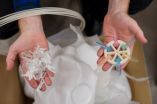(Press-News.org) Researchers at New York University have identified the nature of brain activity that allows us to bridge time in our memories. Their findings, which appear in the latest issue of the journal Neuron, offer new insights into the temporal nature of how we store our recollections and may offer a pathway for addressing memory-related afflictions.
"Our memories are known to be 'altered' versions of reality, and how time is altered has not been well understood," said Lila Davachi, an associate professor in NYU's Department of Psychology and Center for Neural Science and the study's senior author. "These findings pinpoint the brain activity that explains why remember some events as having occurred closer together in time and others further apart."
While our actual experiences are quite fluid and not neatly organized, our memories of them are discrete—like "beads on a string," Davachi explains. However, our recollections of the temporal distance among these events varies—in our memories, sometimes the beads are placed close together in time and sometimes they are spaced further apart.
The neurological process that explains why we place some memories closer together in time than we do others is not clear.
"Temporal information is a key organizing principle of memory, so it's important to understand where this organization comes from," Davachi said.
Understanding this process may lead to ways to address maladies of memory organization, such as schizophrenia, in which the ability to place recollections in temporal order is impaired.
Davachi and her co-author, Youssef Ezzyat, an NYU doctoral student, sought to shed light on this dynamic by studying the brain's hippocampus—a region known to play a significant role in memory.
In this experiment, the researchers had participants look at a series of pictures while monitoring brain activity using functional magnetic resonance imaging (fMRI). The participants viewed objects and faces that were separated in time; each stimulus was also paired with a picture of a scene. For every presentation, the participants were asked to imagine a scenario in which either the object or the face played a role in the scene they just viewed—the process was designed to create, or encode, a series of memories in the participants.
Later, after scanning, the participants performed a retrieval test in which they were presented with two stimuli (i.e., object and face) from the preceding phase and asked to indicate how far apart in time the two items were when they were encoded. Participants were given the following four response options: very close, close, far, and very far.
Their results showed a relationship between hippocampal activity and how close or far in time the participants placed their memories. When hippocampal activity was more stable across time, memories were remembered as having occurred closer together. By contrast, when hippocampal stability was diminished, participants were more likely to recall the memories as having occurred further apart in time.
"Clearly, the hippocampus is vital in determining how we recall the temporal distances between the many memories we hold, and similarity in the brain across time results in greater temporal proximity of those memories," Davachi says.
INFORMATION:
The research was supported by a grant from the National Institute of Mental Health (RO1-MH074692), part of the National Institutes of Health.
Similarity breeds proximity in memory, NYU researchers find
2014-03-05
ELSE PRESS RELEASES FROM THIS DATE:
Are bilingual kids more open-minded?
2014-03-05
This news release is available in French. Montreal, March 5, 2014 — There are clear benefits to raising a bilingual child. But could there be some things learning a second language doesn't produce, such as a more open-minded youngster?
New research from Concordia University shows that, like monolingual children, bilingual children prefer to interact with those who speak their mother tongue with a native accent rather than with peers with a foreign accent.
The study, published in the journal Frontiers in Psychology and co-authored by psychology professors Krista ...
Save money and the planet: Turn your old milk jugs into 3D printer filament
2014-03-05
Making your own stuff with a 3D printer is vastly cheaper than what you'd pay for manufactured goods, even factoring in the cost of buying the plastic filament.
Yet, you can drive the cost down even more by making your own filament from old milk jugs. And, while you are patting yourself on the back for saving 99 cents on the dollar, there's a bonus: you can feel warm and fuzzy about preserving the environment.
A study led by Joshua Pearce of Michigan Technological University has shown that making your own plastic 3D printer filament from milk jugs uses less energy—often ...
Seeking quantum-ness: D-Wave chip passes rigorous tests
2014-03-05
With cutting-edge technology, sometimes the first step scientists face is just making sure it actually works as intended.
The USC Viterbi School of Engineering is home to the USC-Lockheed Martin Quantum Computing Center (QCC), a super-cooled, magnetically shielded facility specially built to house the first commercially available quantum computing processors – devices so advanced that there are only two in use outside the Canadian lab where they were built: The first one went to USC and Lockheed Martin, and the second to NASA and Google.
Since USC's facility opened ...
Calcium and vitamin D improve cholesterol in postmenopausal women
2014-03-05
CLEVELAND, Ohio (March 5, 2014)—Calcium and vitamin D supplements after menopause can improve women's cholesterol profiles. And much of that effect is tied to raising vitamin D levels, finds a new study from the Women's Health Initiative (WHI) just published online in Menopause, the journal of The North American Menopause Society (NAMS).
Whether calcium or vitamin D can indeed improve cholesterol levels has been debated. And studies of women taking the combination could not separate the effects of calcium from those of vitamin D on cholesterol. But this study, led by NAMS ...
Blocking immune system protein in mice prevents fetal brain injury, but not preterm birth
2014-03-05
An inflammatory protein that triggers a pregnant mouse's immune response to an infection or other disease appears to cause brain injury in her fetus, but not the premature birth that was long believed to be linked with such neurologic damage in both rodents and humans, new Johns Hopkins-led research suggests.
The researchers, reporting online March 5 in the American Journal of Reproductive Immunology, also say they found that an anti-inflammatory drug that is FDA-approved for rheumatoid arthritis and is believed to be safe for humans to take during pregnancy halted the ...
New program for students with autism offers hope after high school
2014-03-05
An innovative program from UNC's Frank Porter Graham Child Development Institute (FPG) and 6 partner universities is preparing students with autism for life after high school.
"Public high schools may be one of the last best hopes for adolescents with autism—and for their families," said FPG director Samuel L. Odom. "Many of these students will face unemployment and few social ties after school ends."
According to Odom, teachers and other professionals in the schools work hard to achieve beneficial results for students with autism spectrum disorders (ASD). But positive ...
Darwin: It's not all sexual (selection)
2014-03-05
Since the days of Darwin, scientists have considered bird song to be an exclusively male trait, resulting from sexual selection. Now a team of researchers from the University of Maryland, Baltimore County (UMBC), the University of Melbourne in Australia, Leiden University in the Netherlands and The Australian National University says that's not the whole story.
The team used information from several sources, including the Handbook of the Birds of the World. Their survey included birds from all over the globe, but focused on early-diverging Australasian lineages, which ...
Playing with Barbie dolls could limit girls' career choices, study shows
2014-03-05
CORVALLIS, Ore. – In one of the first experiments to explore the influence of fashion dolls, an Oregon State University researcher has found that girls who play with Barbie dolls see fewer career options for themselves than for boys.
"Playing with Barbie has an effect on girls' ideas about their place in the world," said Aurora M. Sherman, an associate professor in the School of Psychological Science at OSU. "It creates a limit on the sense of what's possible for their future. While it's not a massive effect, it is a measurable and statistically significant effect."
Findings ...
First step towards 'programmable materials'
2014-03-05
Although the "programmable material" still only works in a one-dimensional model construction, it has already demonstrated it unusual capabilities: The research project entitled Phononic Crystal with Adaptive Connectivity has just been published in the journal Advanced Materials. The first step towards mechanical components with freely programmable properties has thus been achieved.
The working model used by the researchers consists of a one-meter by one-centimeter aluminum plate that is one millimeter thick. This sheet-metal strip can vibrate at different frequencies. ...
Research shows patient satisfaction can be high, even in emergency care situations
2014-03-05
MINNEAPOLIS, MN – March 4, 2013 – The Minneapolis Heart Institute Foundation (MHIF) today announced the results of survey research aimed at discovering patient and family satisfaction with acute care transfers for patients with STEMI (ST-segment elevation myocardial infarction), a severe heart attack best treated quickly with specialized care. The results, based on 98 patient and 80 family surveys, suggest that patient satisfaction with care decisions and communication can be high, even in emergency care situations that require rapid and complex decision making and, in ...



